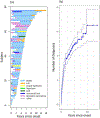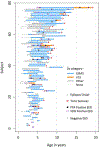Diagnosis switching and outcomes in a cohort of patients with potential epilepsy with myoclonic-atonic seizures
- PMID: 30286391
- PMCID: PMC6223641
- DOI: 10.1016/j.eplepsyres.2018.09.011
Diagnosis switching and outcomes in a cohort of patients with potential epilepsy with myoclonic-atonic seizures
Abstract
Introduction: There is overlap in the electroclinical features of many childhood epilepsy syndromes, especially those presenting with multiple seizure types, such as epilepsy with myoclonic-atonic seizures (EMAS) and Lennox-Gastaut syndrome (LGS). This study aimed to determine the frequency of diagnosis switching and the factors influencing epilepsy syndrome diagnosis in a cohort of children with possible EMAS, as well as to explore the relationship between epilepsy syndrome diagnoses, key electroclinical features, and clinically relevant outcomes.
Methods: This is a cross-sectional retrospective chart review of children treated at the Children's Hospital of Colorado with a potential diagnosis of EMAS.
Results: There were 77 patients that met eligibility criteria, including 39% (n = 30) with an initial diagnosis of EMAS and 74% (n = 57) with a final diagnosis of EMAS. On average, for the 65% of patients who received more than one epilepsy diagnosis, the first, second, and third diagnoses were received within one year, three years, and ten years after epilepsy onset, respectively. Final diagnosis was significantly related to obtaining at least a six-month period of seizure freedom, p = 0.03. Classic LGS traits, including paroxysmal fast activity, slow spike-and-wave, and tonic seizures were present in 50% of the overall cohort, although a minority of these patients had a final diagnosis of LGS. However, the presence of more LGS traits was associated with a higher likelihood of ongoing seizures. Adjusted for age of epilepsy onset, seizure freedom was half as likely for every additional LGS trait observed (0.49[0.31, 0.77], p = 0.002).
Conclusion: Current epilepsy syndrome classification has reduced applicability due to overlapping features. This results in diagnosis switching and limited prognostic value for patients with an overlapping clinical phenotype. Future studies should attempt to stratify patients based not only on epilepsy syndrome diagnosis, but also on the presence of various electroclinical traits to more accurately predict outcome.
Keywords: Epilepsy with myoclonic atonic seizures (EMAS); Lennox-Gastaut syndrome (LGS); Paroxysmal fast activity; Slow spike-and-wave; Tonic seizures.
Copyright © 2018 Elsevier B.V. All rights reserved.
Conflict of interest statement
Disclosures / Conflicts of Interest:
Author SD has consulted for Upsher-Smith on an unrelated subject matter. Author AD serves as an advisor to Merck, Pfizer and Sanofi Pasteur, and works as a consultant for Pfizer. These relationships are also on an unrelated subject matter. Author AD does not receive any research funding from these companies. The remaining authors have no disclosures to report.
Figures



References
-
- Berg AT, Berkovic SF, Brodie MJ, Buchhalter J, Cross JH, van Emde Boas W, Engel J, French J, Glauser TA, Mathern GW, Moshe SL, Nordli D, Plouin P, Scheffer IE, 2010. Revised terminology and concepts for organization of seizures and epilepsies: report of the ILAE Commission on Classification and Terminology, 2005–2009. Epilepsia 51, 676–685. - PubMed
-
- Blume WT, Luders HO, Mizrahi E, Tassinari C, van Emde Boas W, Engel J Jr., 2001. Glossary of descriptive terminology for ictal semiology: report of the ILAE task force on classification and terminology. Epilepsia 42, 1212–1218. - PubMed
-
- Camfield P, Camfield C, 2007. Long-term prognosis for symptomatic (secondarily) generalized epilepsies: a population-based study. Epilepsia 48, 1128–1132. - PubMed
-
- Caraballo RH, Chamorro N, Darra F, Fortini S, Arroyo H, 2013. Epilepsy with myoclonic atonic seizures: an electroclinical study of 69 patients. Pediatr Neurol 48, 355–362. - PubMed
-
- Doose H, 1979. Petit mal status in early childhoodand Dementia. Neuropediatrie 10, 10–14. - PubMed
Publication types
MeSH terms
Grants and funding
LinkOut - more resources
Full Text Sources
Miscellaneous

